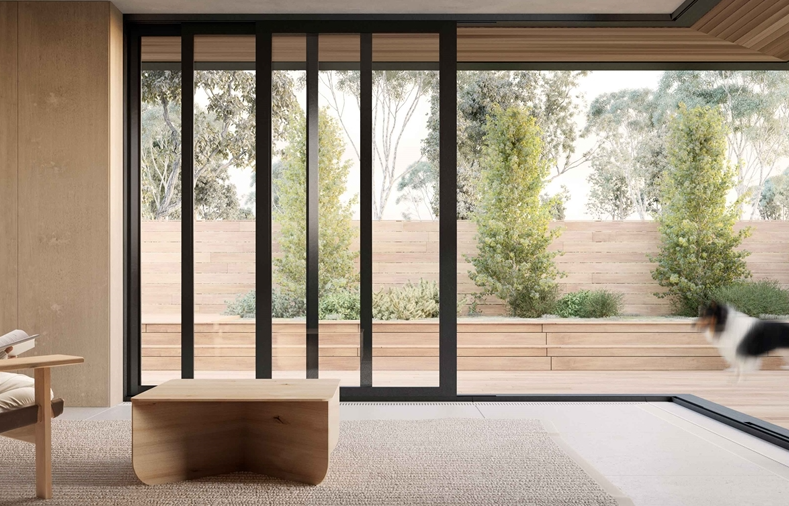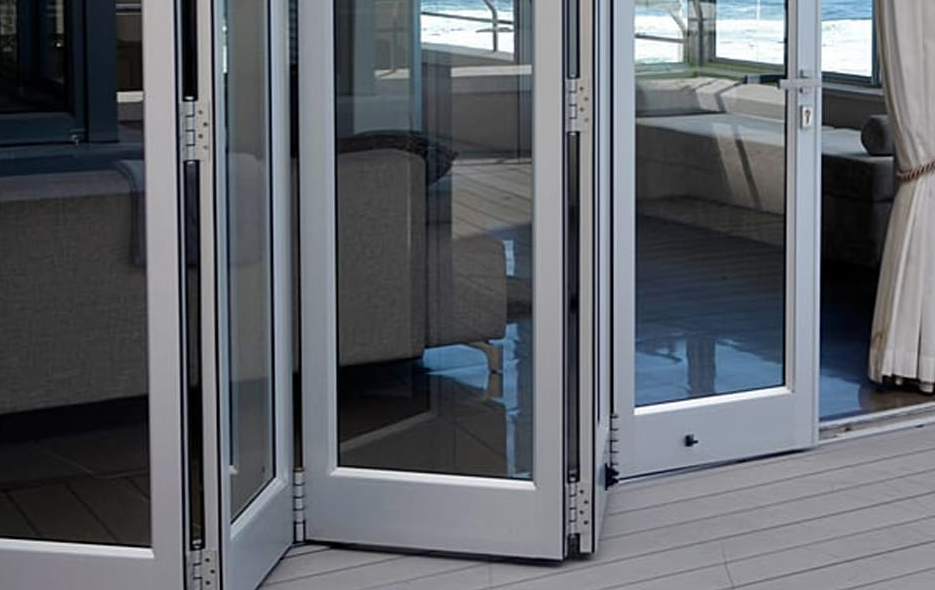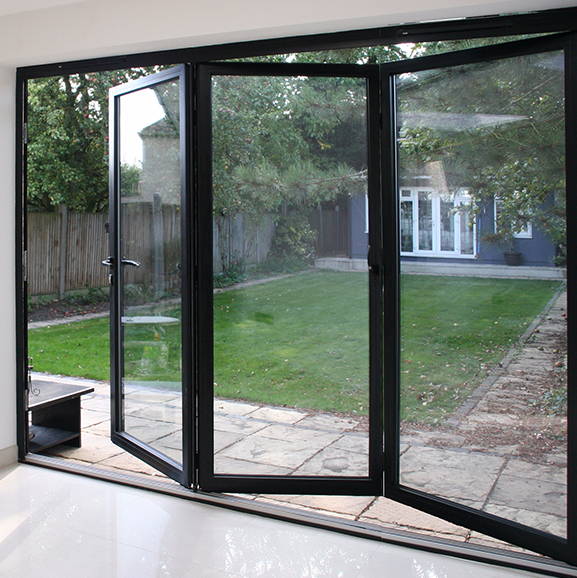A stacking door is a multi-panel door system that slides and stacks behind one another, optimizing space and offering unobstructed views.
Components and Mechanics
When discussing stacking doors, it’s pivotal to delve into their components and how they operate. These doors often integrate sophisticated designs with functional mechanics to serve both aesthetic and utilitarian needs.

Structure and Design
Stacking doors typically consist of multiple panels that glide smoothly along a track. The most noticeable feature is the door panels themselves, which often cover large surface areas and can seamlessly connect indoor and outdoor spaces.
- Panels: These are the main sections that make up the door. They can be large, offering clear views when made of glass.
- Tracks: This is where the panels glide along. Depending on the design, tracks can be single, double, or even triple, allowing for various configurations of door stacking.
- Seals and Weather Stripping: To ensure that the doors are weatherproof, they incorporate seals and weather stripping which not only provide insulation but also enhance the door’s energy efficiency.
Materials Used
Different materials impart various looks, feels, and functionalities to stacking doors. It’s not just about aesthetics; it’s also about durability, maintenance, and energy efficiency.
- Glass: Many stacking doors use tempered glass due to its strength and safety features. It offers clear views and can have UV protection or tinting.
- Aluminum: Lightweight yet robust, aluminum is often used for the frame. It’s corrosion-resistant, making it ideal for areas exposed to harsh weather or coastal environments.
- Wood: For those seeking a more natural or classic look, wood is a go-to choice. Different wood types, like oak or teak, offer varied looks and levels of durability.
Mechanism of Operation
The way stacking doors operate is what sets them apart from traditional doors.
- Gliding Mechanism: This allows the panels to move smoothly along their tracks. Rollers positioned at the base of each panel facilitate this motion, ensuring a seamless glide.
- Locking System: To ensure security, most stacking doors come with a multi-point locking system. This provides enhanced protection against potential intruders.
- Stacking: When fully opened, the panels stack behind each other. This mechanism optimizes space utilization, ensuring that the opened doors consume as little space as possible. The mechanism often requires precision engineering to ensure the panels align correctly and securely when stacked.
Types of Stacking Doors
Stacking doors come in various designs and materials to cater to different tastes, functional needs, and architectural styles. The choice often boils down to the desired aesthetic, level of maintenance, and, of course, the budget. Here’s a closer look at the different types of stacking doors.
Traditional Stacking Doors
Traditional stacking doors are often the go-to choice for those looking for a blend of aesthetics and functionality without specific material constraints.
- Panels: Typically consist of multiple glass panels framed with materials like aluminum or wood.
- Features: These doors offer the signature stacking mechanism, allowing panels to slide and stack neatly, optimizing space.
- Use Cases: Ideal for residential settings, patios, and balconies where homeowners want to blend the indoor and outdoor spaces seamlessly.
- Benefits: Combining the classic look with modern mechanics, they offer reliability and versatility. They’re often available in a broad spectrum of finishes and can be customized to fit specific dimensions.
Frameless Glass Stacking Doors
For those seeking a minimalist and contemporary look, frameless glass stacking doors are the answer.
- Panels: Made entirely of glass, without any visible framing, creating a seamless and uninterrupted view.
- Features: Despite being frameless, these doors boast strong tempered or laminated glass that ensures safety.
- Use Cases: Perfect for modern homes, offices, or commercial spaces aiming for a sleek appearance and an unobstructed view.
- Benefits: Maximizes natural light intake, offers a modern aesthetic, and provides the illusion of a larger space.
Aluminum Stacking Doors
Durable, sleek, and low-maintenance, aluminum stacking doors are in a class of their own.
- Panels: Aluminum frames encapsulating glass panels. The frames can be powder-coated in various colors.
- Features: Known for their strength, these doors resist warping, rusting, and corrosion, ensuring longevity.
- Use Cases: Suitable for coastal homes, areas with volatile weather, or spaces requiring a sleek industrial touch.
- Benefits: Lightweight, sturdy, and requiring minimal maintenance. Aluminum is also recyclable, making it an eco-friendly choice.
Wooden Stacking Doors
Exuding warmth, character, and timeless beauty, wooden stacking doors are for those who value classic elegance.
- Panels: Made from different types of wood, like oak, mahogany, or teak. Each wood type lends a unique finish and grain pattern to the door.
- Features: They offer the warmth and charm that only natural wood can provide. Over time, they might develop a natural patina, adding to their aesthetic appeal.
- Use Cases: Best suited for traditional homes, cottages, or any space that aims for a rustic or classic ambiance.
- Benefits: Natural insulation properties of wood offer better energy efficiency. Additionally, with proper care, wooden doors can last for decades, becoming more beautiful with age.
Advantages and Disadvantages
Choosing the right door style for a home or commercial space is a significant decision. Stacking doors offer numerous advantages but, like all products, come with their set of limitations. Here’s an exploration of both sides of the coin.
Benefits of Using Stacking Doors
Stacking doors have been gaining popularity, and for good reasons:
- Space Optimization: One of the primary advantages of stacking doors is how they save space. When open, the panels stack behind each other, maximizing available room.
- Unobstructed Views: Especially with frameless designs, stacking doors offer uninterrupted vistas, making them perfect for scenic locations or any space where a clear view is desired.
- Natural Light: Their broad panels allow an abundance of natural light to flood the space, enhancing mood and reducing the need for artificial lighting.
- Flexibility: They offer flexibility in terms of opening size. You can slide open as many or as few panels as needed.
- Energy Efficiency: With proper seals and high-quality materials, these doors can act as effective insulators, retaining heat in winter and keeping the space cool in summer.

Potential Drawbacks
While they bring a lot to the table, stacking doors also come with considerations:
- Cost: High-quality stacking doors can be on the pricier side, especially if opting for custom sizes or premium materials.
- Maintenance: Depending on the material, some stacking doors, especially wooden ones, may require periodic maintenance like sealing or refinishing to keep them looking fresh and functioning optimally.
- Security Concerns: Large glass panels might raise security concerns for some users. However, most modern stacking doors come with reinforced glass and advanced locking systems to mitigate this.
- Installation Complexity: Installing these doors requires precision. Misalignment can hinder their functionality, so it’s crucial to have them set up by professionals.
- Potential for Wear and Tear: The sliding and stacking mechanism means there are moving parts that, over time, might experience wear and require replacement or repair.
Applications and Use Cases
Stacking doors, given their versatility and aesthetic appeal, find applications in a multitude of settings. From homes to office spaces and industrial warehouses, the functionality they bring is vast and varied.
Residential Uses
For homeowners, stacking doors can revolutionize how spaces connect and flow.
- Indoor-Outdoor Connection: Homes with patios, gardens, or terraces benefit immensely. Open the doors, and suddenly, there’s a seamless transition from the living room to the outdoors.
- Natural Light Maximization: In apartments or houses craving light, these doors act as large windows, inviting sunlight to brighten interiors.
- Room Dividers: Within homes, they can act as stylish dividers between spaces like the kitchen and dining area or the master bedroom and an adjoining balcony.
- Aesthetic Appeal: Their sleek design can elevate the overall look of a house, offering a blend of modern architecture with practical functionality.
Commercial Uses
In commercial settings, stacking doors cater to both functionality and branding needs.
- Restaurants and Cafes: For eateries with outdoor seating, these doors allow for a flexible dining space. On pleasant days, they can be opened for an alfresco experience.
- Retail Stores: Shops in malls or standalone ones can use stacking doors as a unique storefront, providing an unobstructed view of merchandise and attracting customers.
- Offices: Modern office spaces, especially those following the open office concept, can utilize these doors to partition areas without sacrificing the sense of spaciousness.
- Hotels and Resorts: In beachfront properties or resorts nestled in nature, stacking doors offer guests panoramic views from their rooms or lobbies.
Industrial Uses
While not the first application one might think of, industrial settings also find value in stacking doors.
- Warehouses: For warehouses requiring large entryways to move goods, especially bulky items, these doors can be both practical and space-saving.
- Hangars: Aircraft hangars, where massive entry points are needed, can benefit from custom-sized stacking doors.
- Manufacturing Units: In factories where different sections need to be cordoned off temporarily, these doors can provide flexible partitions.
- Workshops: In settings like car workshops where large items need to move in and out frequently, stacking doors can offer the necessary width and ease of operation.

Installation and Maintenance
Stacking doors, while exceptionally functional and attractive, require precision during installation and consistent care throughout their lifecycle. Properly installed and maintained doors not only last longer but also function smoothly and safely.
Installation Guidelines
Installing stacking doors is a precise task, and while many homeowners might be tempted to do it themselves, seeking professional help is often recommended.
- Measure Twice: Before purchasing, ensure accurate measurements of the opening where the door will fit. This reduces chances of gaps or misalignments.
- Level Ground: The ground or track where the door will slide should be perfectly level to ensure smooth movement and prevent future issues.
- Weather Stripping: To enhance the door’s insulation properties, consider installing weather stripping. This can keep out drafts and improve energy efficiency.
- Safety First: Always wear safety gear like gloves and safety glasses. If you choose to install yourself, ensure you understand all steps and have an assistant to help, given the size and weight of the panels.
- Test After Installation: Once installed, test the door several times to ensure it slides and stacks smoothly. Adjustments are easier to make at this stage.
Routine Maintenance Tips
To keep your stacking doors in top condition, regular maintenance is key.
- Clean Regularly: Use a soft cloth and a mild detergent to clean the glass panels. For frames, especially aluminum or wood, specific cleaners can maintain their sheen.
- Lubricate the Tracks: Over time, the sliding mechanism can face wear. Periodically lubricating the tracks ensures the doors slide smoothly.
- Inspect Seals and Weather Stripping: Check for any signs of wear or damage and replace if necessary. This maintains the door’s insulation properties.
- Avoid Using Abrasives: When cleaning, avoid abrasive materials or cleaners that can scratch the glass or damage the frame.
- Tighten Loose Components: Periodically check screws, handles, and other fixtures. Tighten any that appear loose.
Troubleshooting Common Issues
Like any fixture, stacking doors might face occasional issues. Here’s how to address some common ones:
- Sticking Doors: If the door doesn’t slide smoothly, check the track for debris or dirt. Cleaning and lubricating often solves this issue.
- Misalignment: If panels don’t stack neatly or there’s a gap, it might be a sign of misalignment. While minor adjustments can be done at home, significant misalignments might require professional intervention.
- Locking Issues: If the door doesn’t lock properly, inspect the lock mechanism for any obstructions or damage. In some cases, replacing the lock might be necessary.
- Drafts: Feeling a draft even when the door is closed? Inspect the seals and weather stripping. They might need replacement.
